2010 JAGUAR XF language
[x] Cancel search: languagePage 26 of 225
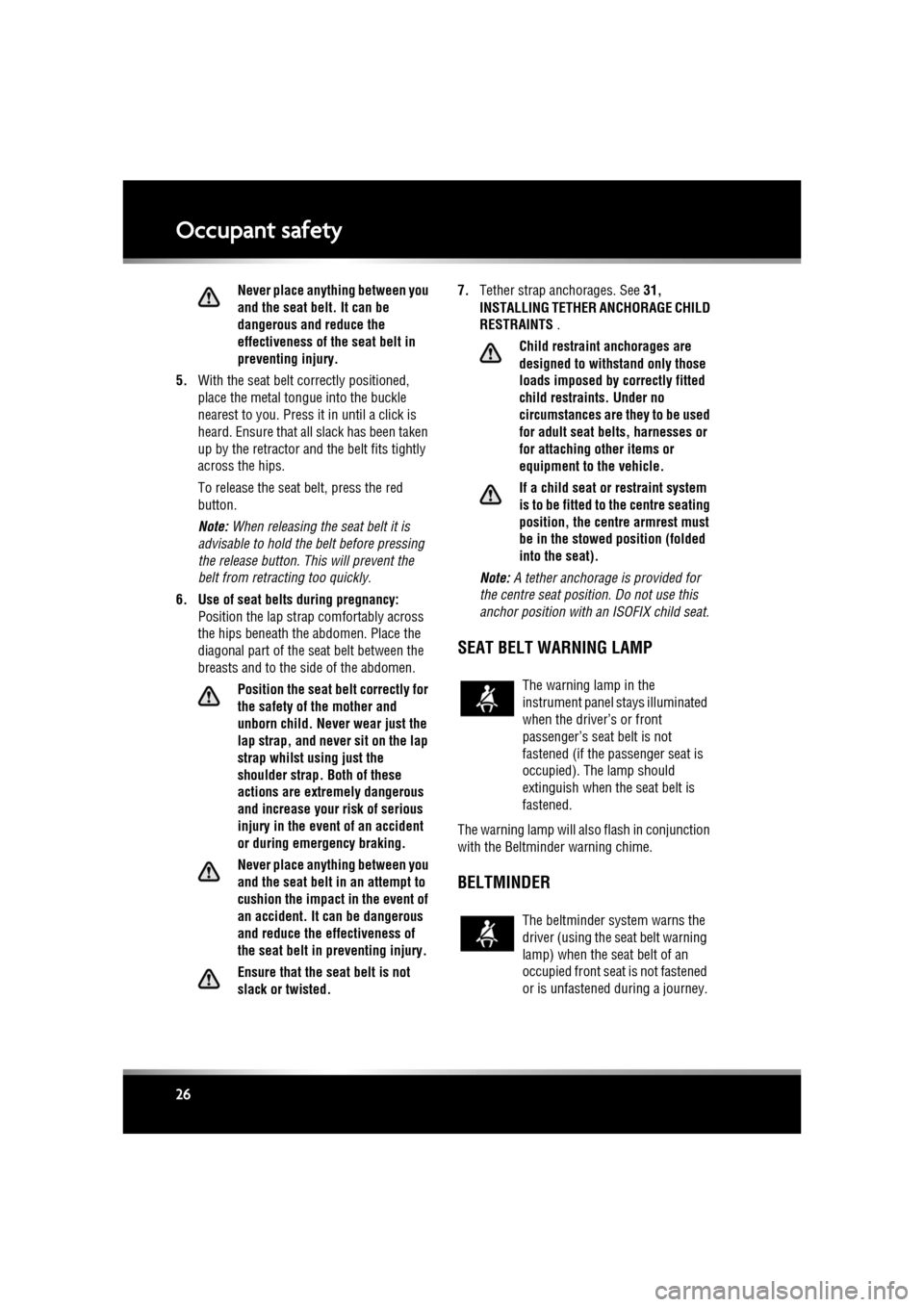
L
(FM8) SEMCON JLR OWNER GUIDE VER 1.00 EURO
LANGUAGE: english-en; MARQUE: jaguar; MODEL: XF
Occupant safety
26
Never place anything between you
and the seat belt. It can be
dangerous and reduce the
effectiveness of t he seat belt in
preventing injury.
5. With the seat belt correctly positioned,
place the metal tongue into the buckle
nearest to you. Press it in until a click is
heard. Ensure that all slack has been taken
up by the retractor and the belt fits tightly
across the hips.
To release the seat belt, press the red
button.
Note: When releasing the seat belt it is
advisable to hold the belt before pressing
the release button. This will prevent the
belt from retracting too quickly.
6. Use of seat belts during pregnancy:
Position the lap strap comfortably across
the hips beneath the abdomen. Place the
diagonal part of the se at belt between the
breasts and to the side of the abdomen.
Position the seat belt correctly for
the safety of the mother and
unborn child. Never wear just the
lap strap, and never sit on the lap
strap whilst using just the
shoulder strap. Both of these
actions are extremely dangerous
and increase your risk of serious
injury in the event of an accident
or during emergency braking.
Never place anything between you
and the seat belt in an attempt to
cushion the impact in the event of
an accident. It can be dangerous
and reduce the effectiveness of
the seat belt in preventing injury.
Ensure that the seat belt is not
slack or twisted. 7.
Tether strap anchorages. See 31,
INSTALLING TETHER ANCHORAGE CHILD
RESTRAINTS .
Child restraint anchorages are
designed to withstand only those
loads imposed by correctly fitted
child restraints. Under no
circumstances are they to be used
for adult seat belts, harnesses or
for attaching other items or
equipment to the vehicle.
If a child seat or restraint system
is to be fitted to the centre seating
position, the centre armrest must
be in the stowed position (folded
into the seat).
Note: A tether anchorage is provided for
the centre seat positio n. Do not use this
anchor position with an ISOFIX child seat.
SEAT BELT WARNING LAMP
The warning lamp will also flash in conjunction
with the Beltminder warning chime.
BELTMINDER
The warning lamp in the
instrument panel stays illuminated
when the driver’s or front
passenger’s seat belt is not
fastened (if the passenger seat is
occupied). The lamp should
extinguish when th e seat belt is
fastened.
The beltminder system warns the
driver (using the seat belt warning
lamp) when the seat belt of an
occupied front seat is not fastened
or is unfastened during a journey.
Page 27 of 225
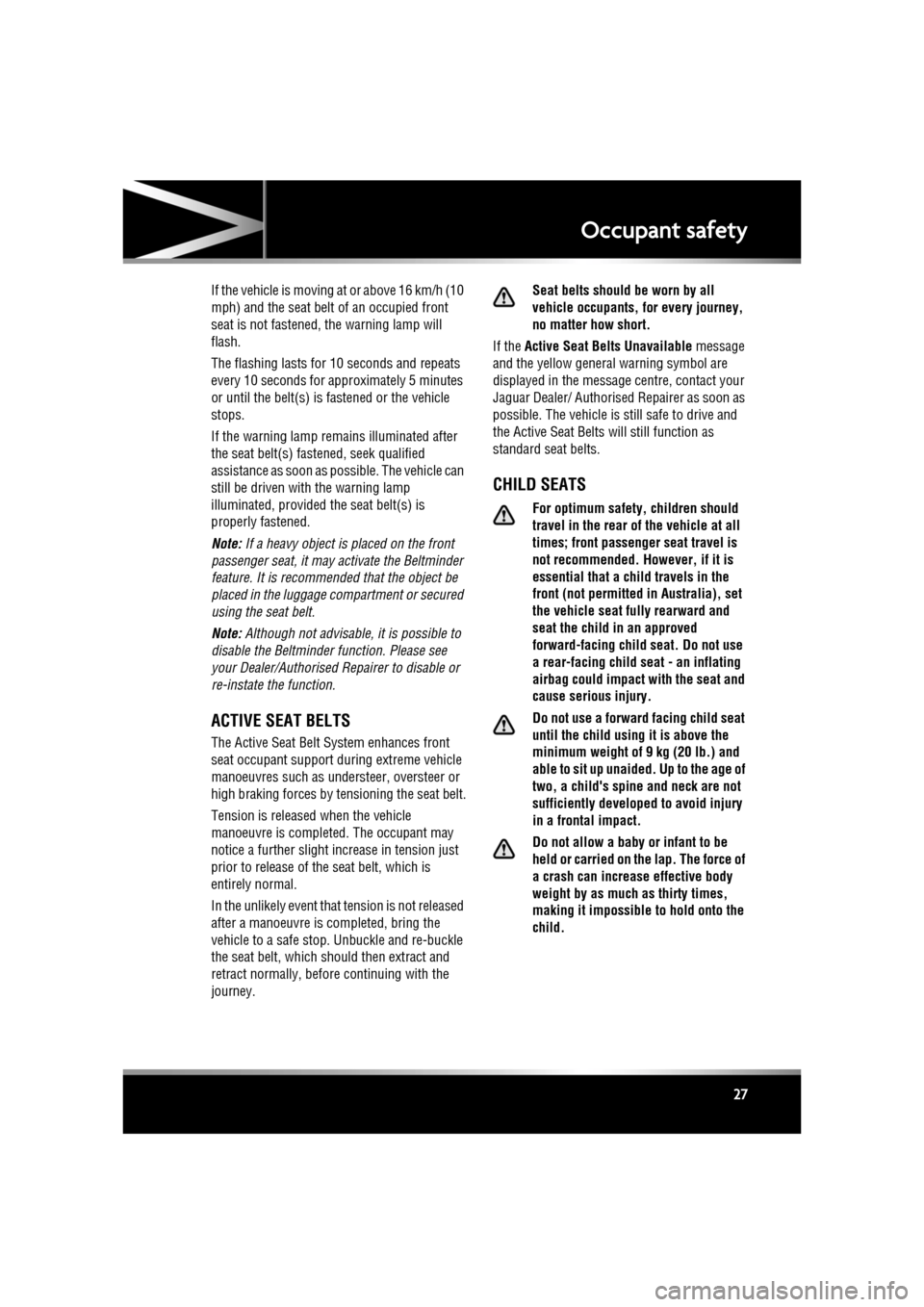
R
(FM8) SEMCON JLR OWNER GUIDE VER 1.00 EURO
LANGUAGE: english-en; MARQUE: jaguar; MODEL: XF
Occupant safety
27
If the vehicle is moving at or above 16 km/h (10
mph) and the seat belt of an occupied front
seat is not fastened, the warning lamp will
flash.
The flashing lasts for 10 seconds and repeats
every 10 seconds for approximately 5 minutes
or until the belt(s) is fastened or the vehicle
stops.
If the warning lamp re mains illuminated after
the seat belt(s) fastened, seek qualified
assistance as soon as pos sible. The vehicle can
still be driven with the warning lamp
illuminated, provided the seat belt(s) is
properly fastened.
Note: If a heavy object is placed on the front
passenger seat, it may activate the Beltminder
feature. It is recomme nded that the object be
placed in the luggage compartment or secured
using the seat belt.
Note: Although not advisable, it is possible to
disable the Beltminder function. Please see
your Dealer/Authorised Repairer to disable or
re-instate the function.
ACTIVE SEAT BELTS
The Active Seat Belt System enhances front
seat occupant support during extreme vehicle
manoeuvres such as understeer, oversteer or
high braking forces by te nsioning the seat belt.
Tension is released when the vehicle
manoeuvre is completed. The occupant may
notice a further slight in crease in tension just
prior to release of th e seat belt, which is
entirely normal.
In the unlikely event that tension is not released
after a manoeuvre is completed, bring the
vehicle to a safe stop. Unbuckle and re-buckle
the seat belt, which should then extract and
retract normally, before continuing with the
journey. Seat belts should be worn by all
vehicle occupants, for every journey,
no matter how short.
If the Active Seat Belts Unavailable message
and the yellow general warning symbol are
displayed in the message centre, contact your
Jaguar Dealer/ Authorised Repairer as soon as
possible. The vehicle is still safe to drive and
the Active Seat Belts will still function as
standard seat belts.
CHILD SEATS
For optimum safety, children should
travel in the rear of the vehicle at all
times; front passenger seat travel is
not recommended. However, if it is
essential that a child travels in the
front (not permitted in Australia), set
the vehicle seat fully rearward and
seat the child in an approved
forward-facing child seat. Do not use
a rear-facing child seat - an inflating
airbag could impact with the seat and
cause serious injury.
Do not use a forward facing child seat
until the child usin g it is above the
minimum weight of 9 kg (20 lb.) and
able to sit up unaided. Up to the age of
two, a child's spine and neck are not
sufficiently developed to avoid injury
in a frontal impact.
Do not allow a baby or infant to be
held or carried on the lap. The force of
a crash can increase effective body
weight by as much as thirty times,
making it impossible to hold onto the
child.
Page 28 of 225
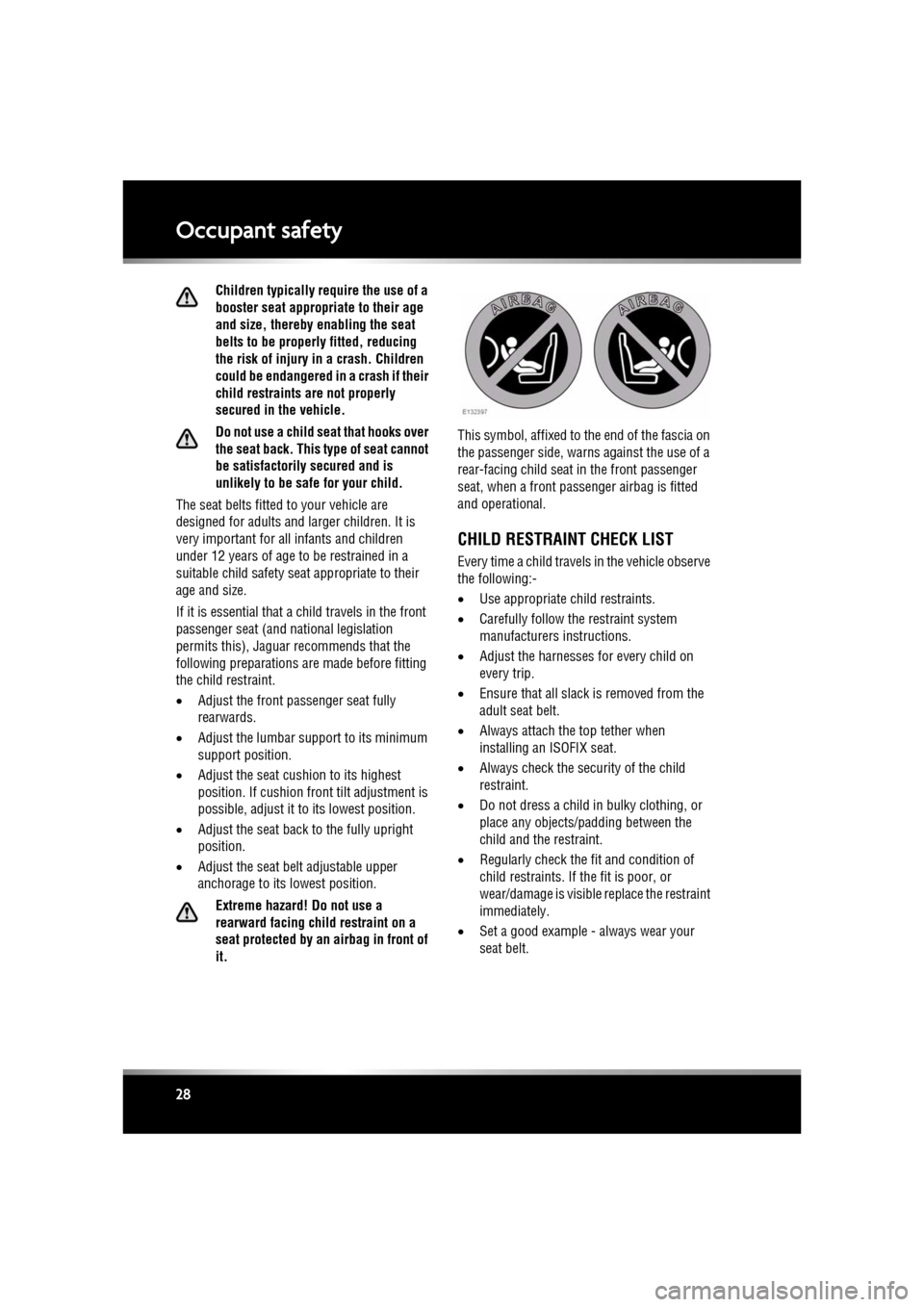
L
(FM8) SEMCON JLR OWNER GUIDE VER 1.00 EURO
LANGUAGE: english-en; MARQUE: jaguar; MODEL: XF
Occupant safety
28
Children typically require the use of a
booster seat appropriate to their age
and size, thereby enabling the seat
belts to be properly fitted, reducing
the risk of injury in a crash. Children
could be endangered in a crash if their
child restraints are not properly
secured in the vehicle.
Do not use a child seat that hooks over
the seat back. This type of seat cannot
be satisfactorily secured and is
unlikely to be safe for your child.
The seat belts fitted to your vehicle are
designed for adults and larger children. It is
very important for all infants and children
under 12 years of age to be restrained in a
suitable child safety seat appropriate to their
age and size.
If it is essential that a child travels in the front
passenger seat (and national legislation
permits this), Jaguar recommends that the
following preparations ar e made before fitting
the child restraint.
• Adjust the front passenger seat fully
rearwards.
• Adjust the lumbar support to its minimum
support position.
• Adjust the seat cushion to its highest
position. If cushion front tilt adjustment is
possible, adjust it to its lowest position.
• Adjust the seat back to the fully upright
position.
• Adjust the seat be lt adjustable upper
anchorage to its lowest position.
Extreme hazard! Do not use a
rearward facing child restraint on a
seat protected by an airbag in front of
it. This symbol, affixed to th
e end of the fascia on
the passenger side, warn s against the use of a
rear-facing child seat in the front passenger
seat, when a front passenger airbag is fitted
and operational.
CHILD RESTRAINT CHECK LIST
Every time a child travels in the vehicle observe
the following:-
• Use appropriate child restraints.
• Carefully follow the restraint system
manufacturers instructions.
• Adjust the harnesses for every child on
every trip.
• Ensure that all slack is removed from the
adult seat belt.
• Always attach the top tether when
installing an ISOFIX seat.
• Always check the security of the child
restraint.
• Do not dress a child in bulky clothing, or
place any objects/padding between the
child and the restraint.
• Regularly check the fit and condition of
child restraints. If the fit is poor, or
wear/damage is visible replace the restraint
immediately.
• Set a good example - al ways wear your
seat belt.
Page 29 of 225
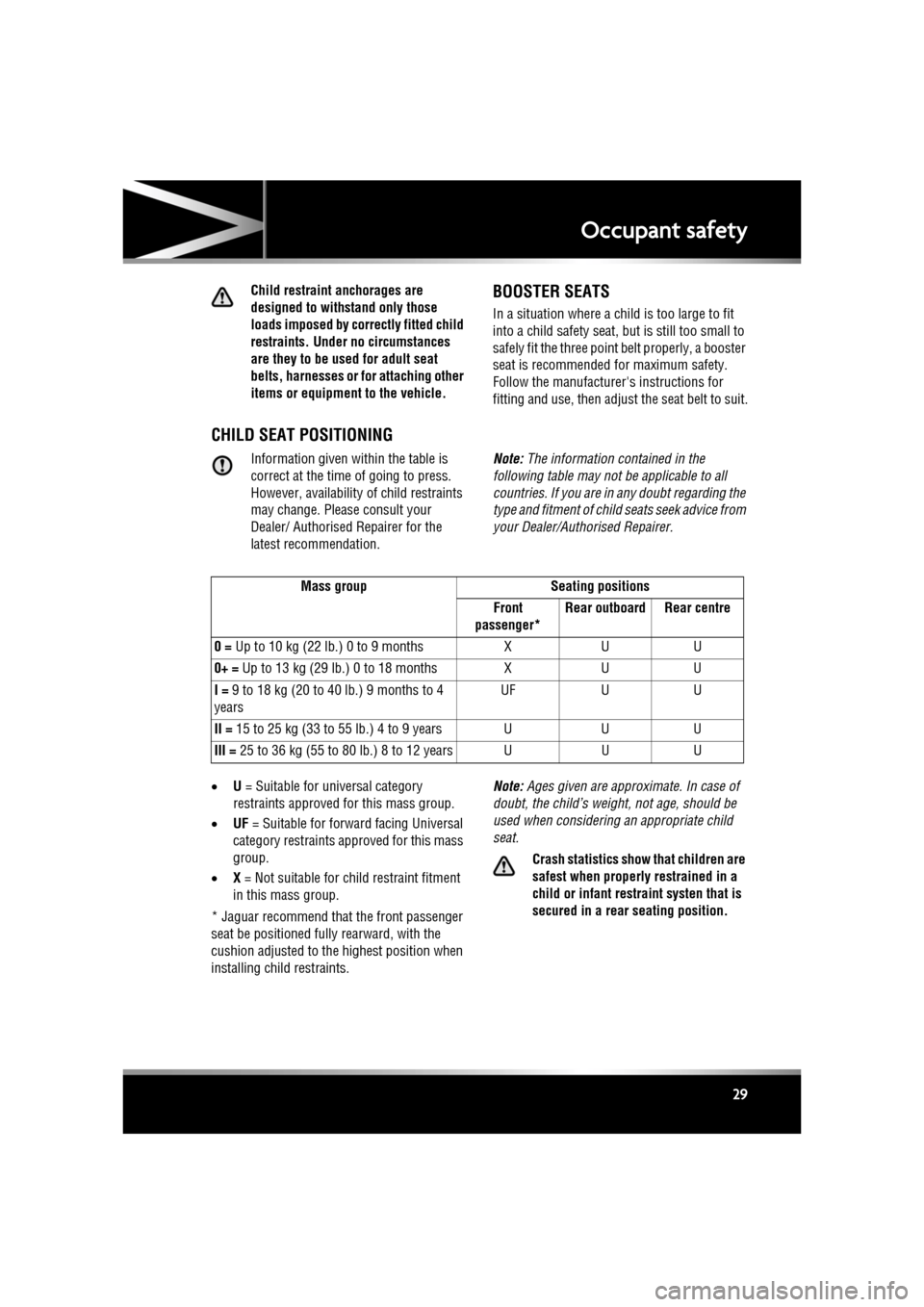
R
(FM8) SEMCON JLR OWNER GUIDE VER 1.00 EURO
LANGUAGE: english-en; MARQUE: jaguar; MODEL: XF
Occupant safety
29
Child restraint anchorages are
designed to withstand only those
loads imposed by corre ctly fitted child
restraints. Under no circumstances
are they to be used for adult seat
belts, harnesses or for attaching other
items or equipment to the vehicle.BOOSTER SEATS
In a situation where a child is too large to fit
into a child safety seat, but is still too small to
safely fit the three point belt properly, a booster
seat is recommended for maximum safety.
Follow the manufacturer's instructions for
fitting and use, then adjust the seat belt to suit.
CHILD SEAT POSITIONING
Information given wi thin the table is
correct at the time of going to press.
However, availability of child restraints
may change. Please consult your
Dealer/ Authorised Repairer for the
latest recommendation. Note:
The information contained in the
following table may not be applicable to all
countries. If you are in any doubt regarding the
type and fitment of child seats seek advice from
your Dealer/Authorised Repairer.
• U = Suitable for universal category
restraints approved for this mass group.
• UF = Suitable for forward facing Universal
category restraints appr oved for this mass
group.
• X = Not suitable for ch ild restraint fitment
in this mass group.
* Jaguar recommend that the front passenger
seat be positioned fully rearward, with the
cushion adjusted to the highest position when
installing child restraints. Note:
Ages given are approximate. In case of
doubt, the child’s weight , not age, should be
used when considering an appropriate child
seat.
Crash statistics show that children are
safest when properly restrained in a
child or infant rest raint systen that is
secured in a rear seating position.
Mass group Seating positions
Front
passenger* Rear outboard Rear centre
0 = Up to 10 kg (22 lb.) 0 to 9 months XUU
0+ = Up to 13 kg (29 lb.) 0 to 18 months X UU
I = 9 to 18 kg (20 to 40 lb.) 9 months to 4
years UF
UU
II = 15 to 25 kg (33 to 55 lb.) 4 to 9 years U UU
III = 25 to 36 kg (55 to 80 lb.) 8 to 12 years U UU
Page 30 of 225
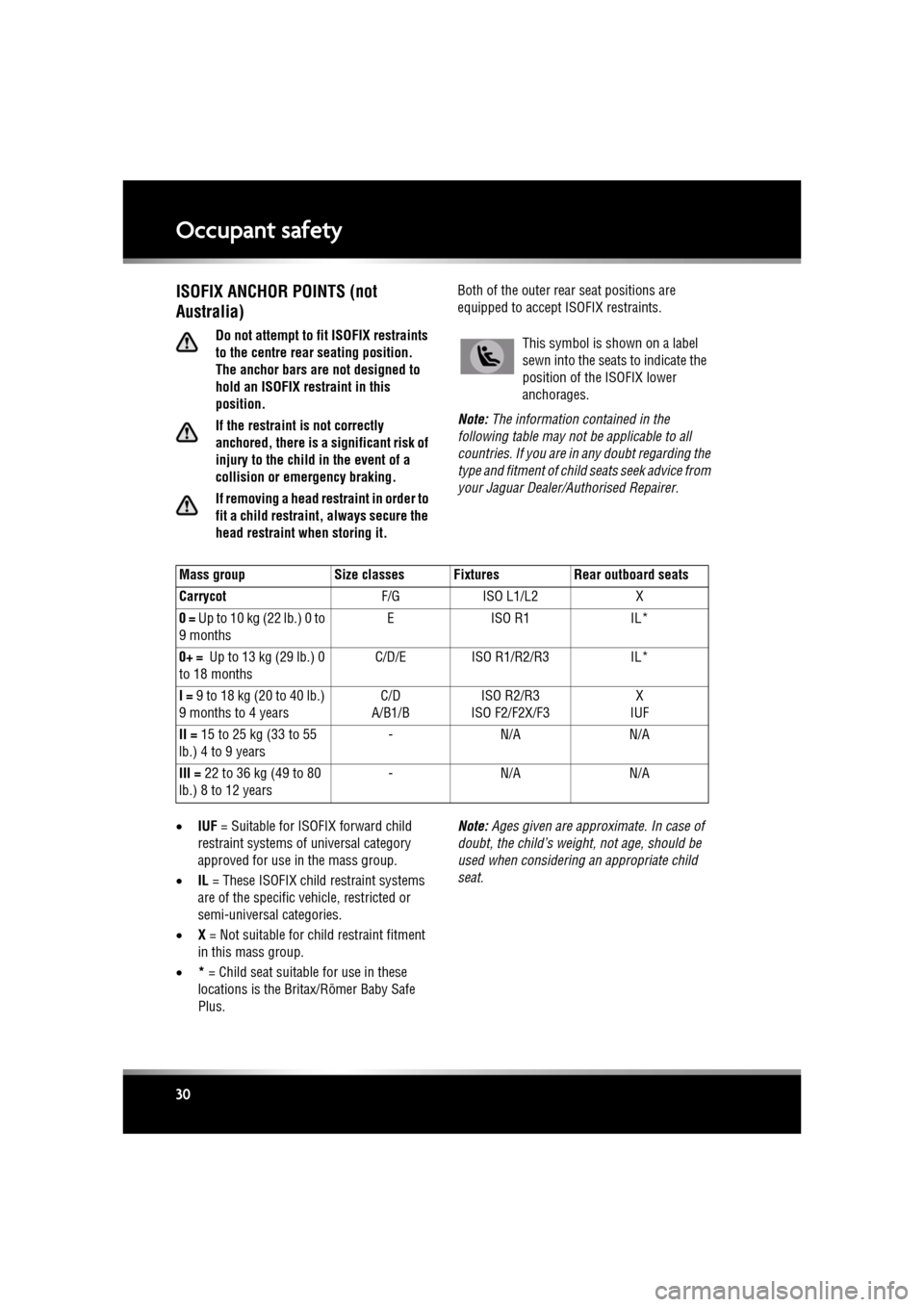
L
(FM8) SEMCON JLR OWNER GUIDE VER 1.00 EURO
LANGUAGE: english-en; MARQUE: jaguar; MODEL: XF
Occupant safety
30
ISOFIX ANCHOR POINTS (not
Australia)
Do not attempt to fit ISOFIX restraints
to the centre rear seating position.
The anchor bars are not designed to
hold an ISOFIX restraint in this
position.
If the restraint is not correctly
anchored, there is a si gnificant risk of
injury to the child in the event of a
collision or em ergency braking.
If removing a head restraint in order to
fit a child restraint, always secure the
head restraint when storing it. Both of the outer rear seat positions are
equipped to accept
ISOFIX restraints.
Note: The information contained in the
following table may not be applicable to all
countries. If you are in any doubt regarding the
type and fitment of child seats seek advice from
your Jaguar Dealer/A uthorised Repairer.
• IUF = Suitable for ISOFIX forward child
restraint systems of universal category
approved for use in the mass group.
• IL = These ISOFIX child restraint systems
are of the specific vehicle, restricted or
semi-universal categories.
• X = Not suitable for ch ild restraint fitment
in this mass group.
• * = Child seat suitable for use in these
locations is the Britax/Römer Baby Safe
Plus. Note:
Ages given are approximate. In case of
doubt, the child’s weight , not age, should be
used when considering an appropriate child
seat.This symbol is shown on a label
sewn into the seats to indicate the
position of the ISOFIX lower
anchorages.
Mass group Size classes Fixtures Rear outboard seats
Carrycot F/GISO L1/L2 X
0 = U p t o 1 0 k g ( 2 2 l b. ) 0 t o
9 months EI
SO R 1 I L*
0+ = Up to 13 kg (29 lb.) 0
to 18 months C/D/E ISO R1/R2/R3
IL*
I = 9 to 18 kg (20 to 40 lb.)
9 months to 4 years C/D
A/B1/B ISO R2/R3
ISO F2/F2X/F3 X
IUF
II = 15 to 25 kg (33 to 55
lb.) 4 to 9 years -N
/A N /A
III = 22 to 36 kg (49 to 80
lb.) 8 to 12 years -N
/A N /A
Page 31 of 225
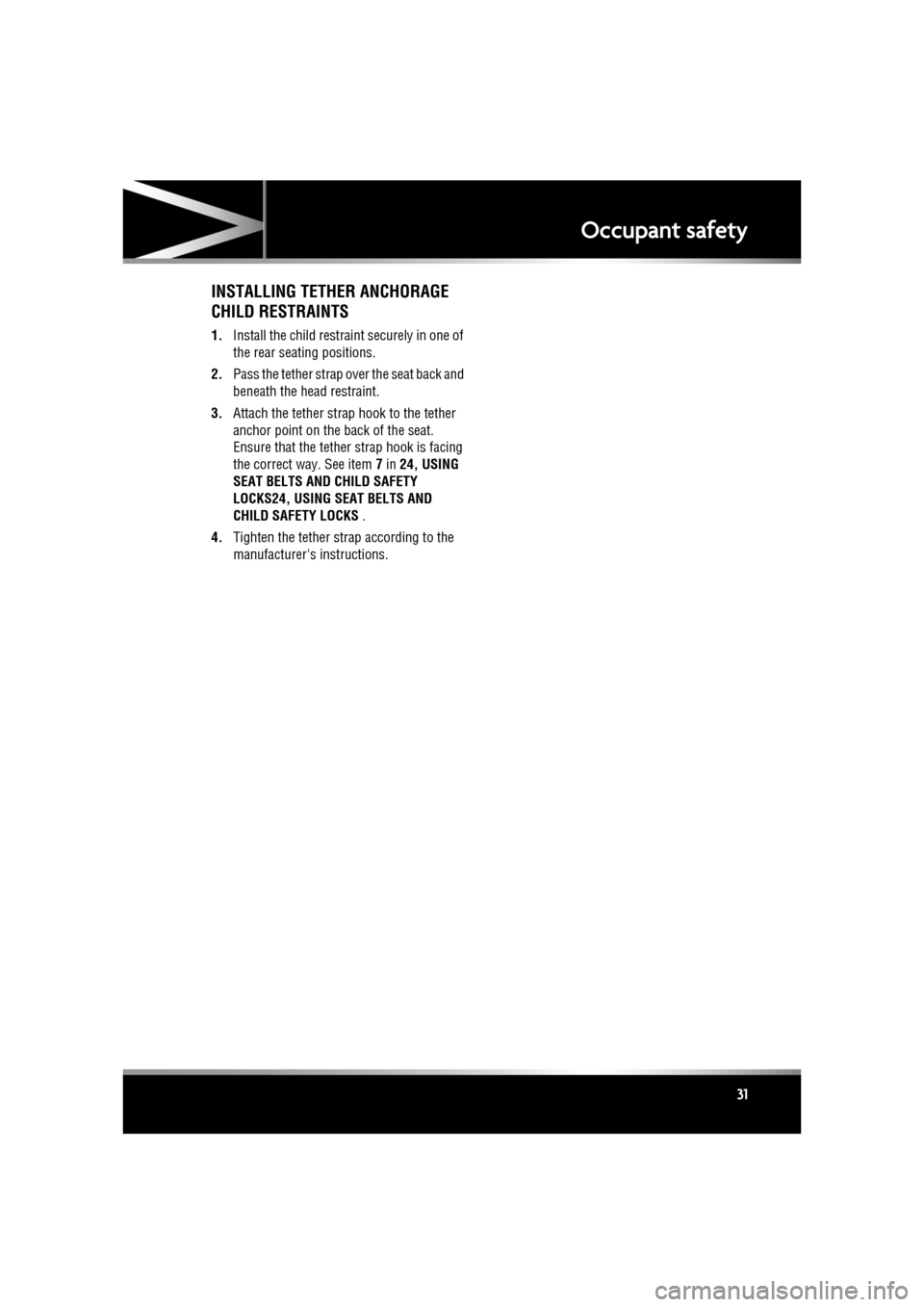
R
(FM8) SEMCON JLR OWNER GUIDE VER 1.00 EURO
LANGUAGE: english-en; MARQUE: jaguar; MODEL: XF
Occupant safety
31
INSTALLING TETHER ANCHORAGE
CHILD RESTRAINTS
1. Install the child restraint securely in one of
the rear seating positions.
2. Pass the tether strap over the seat back and
beneath the head restraint.
3. Attach the tether strap hook to the tether
anchor point on the back of the seat.
Ensure that the tether strap hook is facing
the correct way. See item 7 in 24, USING
SEAT BELTS AND CHILD SAFETY
LOCKS24, USING SEAT BELTS AND
CHILD SAFETY LOCKS .
4. Tighten the tether strap according to the
manufacturer's instructions.
Page 32 of 225
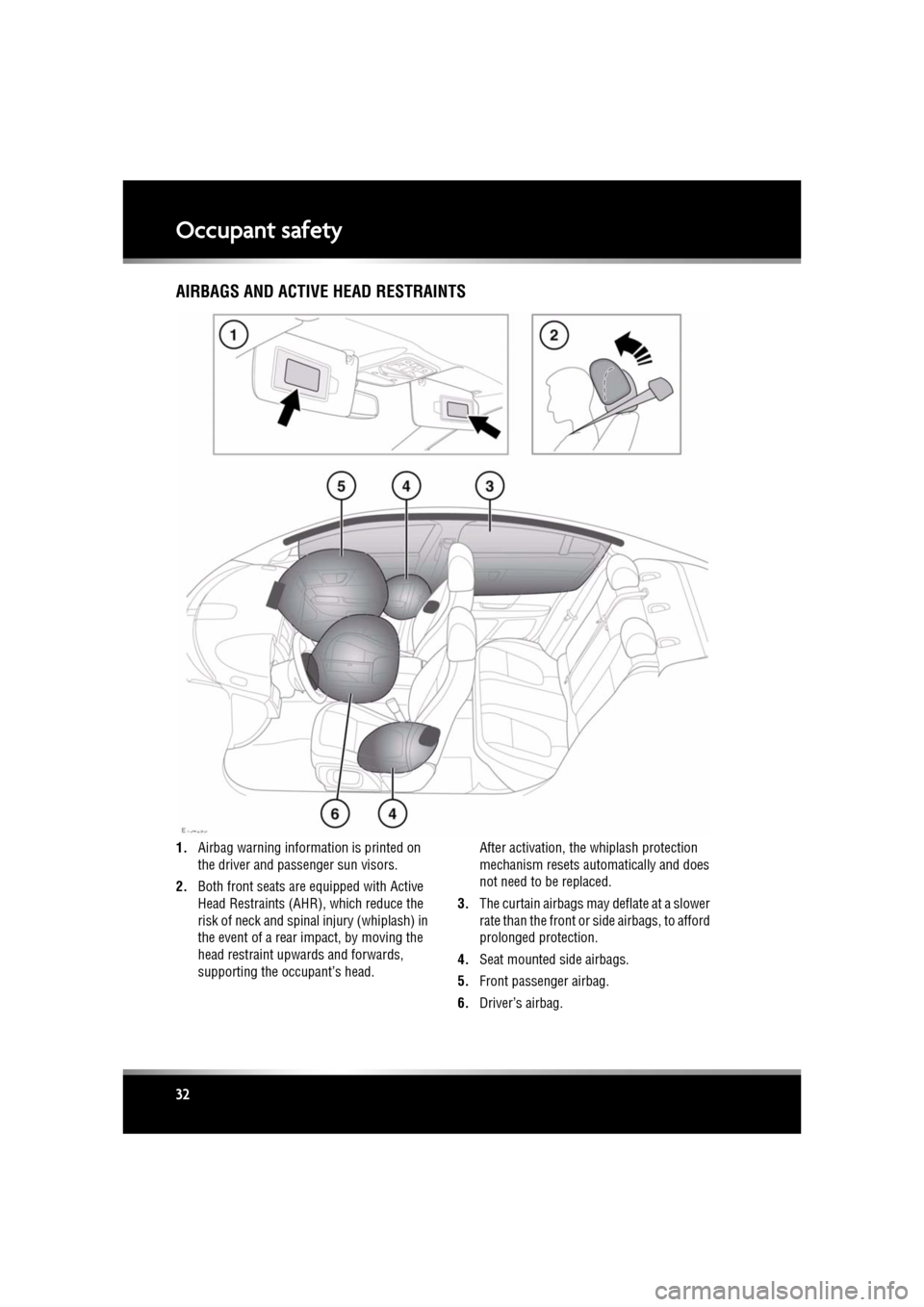
L
(FM8) SEMCON JLR OWNER GUIDE VER 1.00 EURO
LANGUAGE: english-en; MARQUE: jaguar; MODEL: XF
Occupant safety
32
AIRBAGS AND ACTIVE HEAD RESTRAINTS
1. Airbag warning information is printed on
the driver and passenger sun visors.
2. Both front seats are equipped with Active
Head Restraints (AHR ), which reduce the
risk of neck and spinal injury (whiplash) in
the event of a rear impact, by moving the
head restraint upwards and forwards,
supporting the occupant’s head. After activation, the whiplash protection
mechanism resets automatically and does
not need to be replaced.
3. The curtain airbags may deflate at a slower
rate than the front or side airbags, to afford
prolonged protection.
4. Seat mounted side airbags.
5. Front passenger airbag.
6. Driver’s airbag.
Page 33 of 225

R
(FM8) SEMCON JLR OWNER GUIDE VER 1.00 EURO
LANGUAGE: english-en; MARQUE: jaguar; MODEL: XF
Occupant safety
33
Note: The general location of airbags fitted to
the vehicle are marked by the word AIRBAG.
Always contact your Dealer/Authorised
repairer if:
• An airbag inflates.
• The front or sides of the vehicle are
damaged.
• Any part of the Airbag Supplementary
Restraint System (S RS) shows signs of
cracking or damage, including trim
covering airbags.
AIRBAG OPERATION
For the airbags to operate correctly
the roof lining and door post trims
must be in good condition, correctly
fitted, and free from obstruction. Any
damage, wear, or incorrect fitment
should be referred to your Dealer/
Authorised repairer as soon as
possible for exam ination and repair.
Do not obstruct th e operation of the
airbags by placing any part of their
person or any objects in contact with,
or close to, an airbag module. Only
use approved accessories (e.g. seat
covers).
Ensure that a gap is maintained
between the side of the vehicle, and
the head and torso. This will enable
unobstructed inflation of the curtain,
and seat mounted side airbags.
Airbags inflate at high speeds. To
minimise the risk of injury, ensure
that all vehicle occupants wear
correctly positioned seat belts, sit
correctly in the s eats, and position the
seats as far back as practical. Airbag inflation takes place
instantaneously, and cannot protect
against the effects of secondary
impacts. Under these circumstances
the only protection will be provided by
a correctly worn seat belt.
Phone systems should only be
installed by qualified persons familiar
with the operation of, and
requirements for, vehi
cles fitted with
SRS. If you are in any doubt, seek
advice from your Dealer/Authorised
repairer.
Airbag deployment is de pendent on the rate at
which the passenger compartment changes
velocity following the collision. Circumstances
affecting different collis ions (vehicle speed,
angle of impact, type an d size of object hit,
etc.), vary considerably and will affect the rate
of deceleration accordingly.
The Supplementary Rest raint System (SRS)
components include:-
• SRS warning indicator.
• Rotary coupler.
• Airbag modules.
• Seat belt pre-te nsioners (front seat belts).
• Airbag diagnostic control unit.
• Crash sensors.
• Airbag wiring harnesses.
The SRS is not designed to operate as a result
of:
• Rear impacts.
• Minor front impacts.
• Minor side impacts.
• Heavy braking.
• Driving over bumps and pot holes.
Therefore, it follows that considerable
superficial damage to the vehicle can occur,
without causing the airbags to deploy.